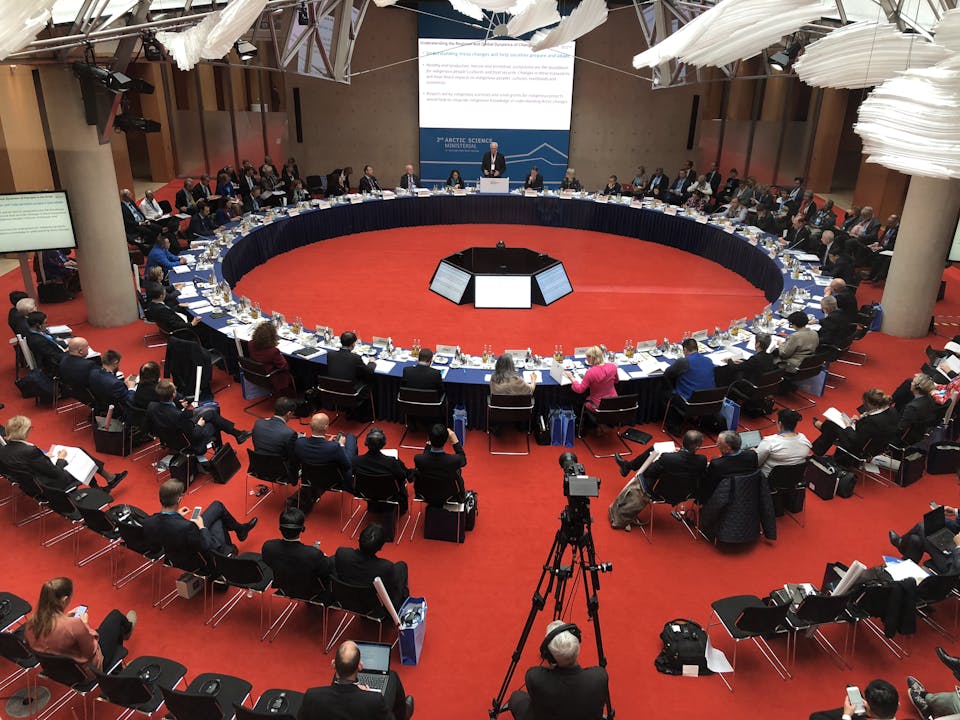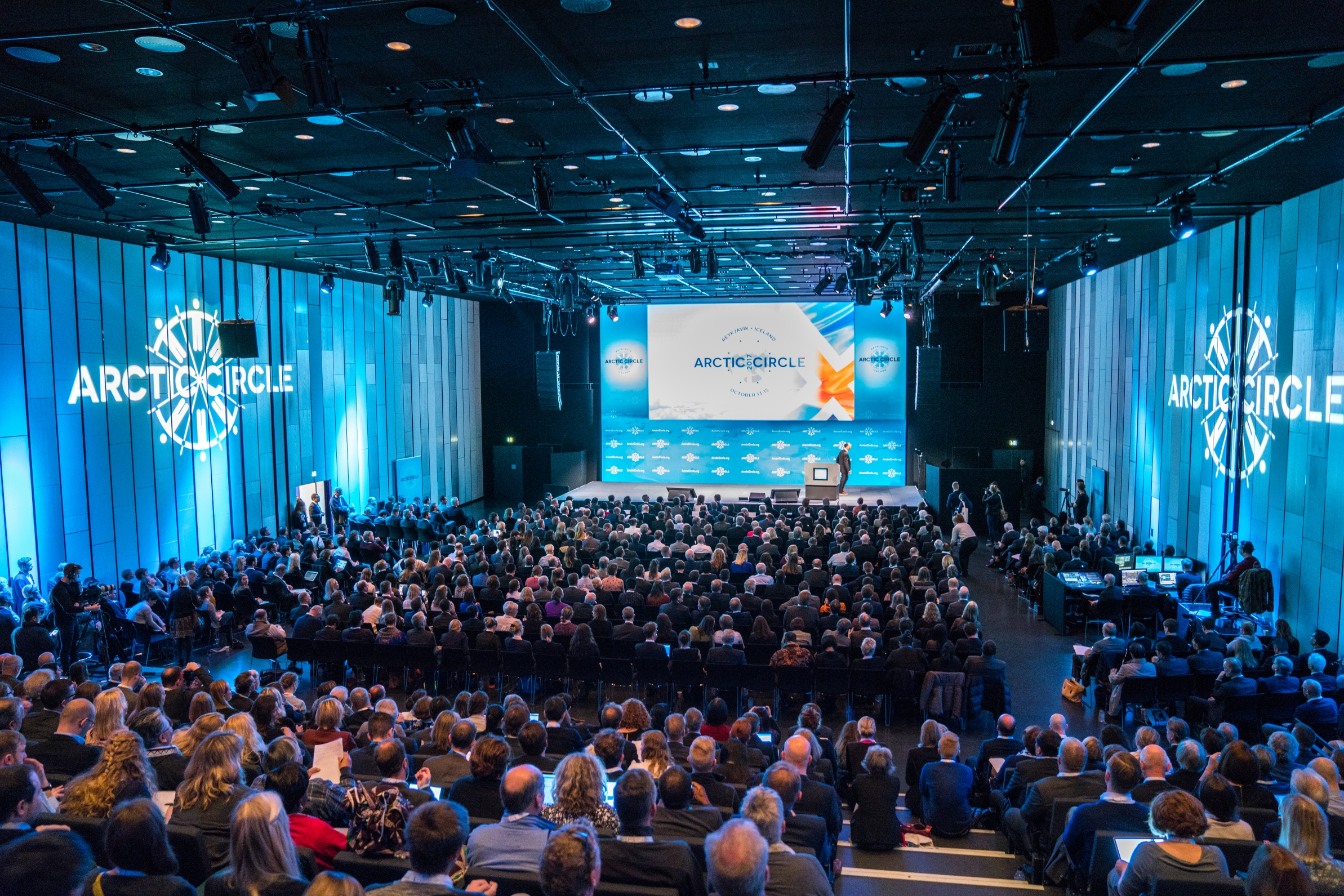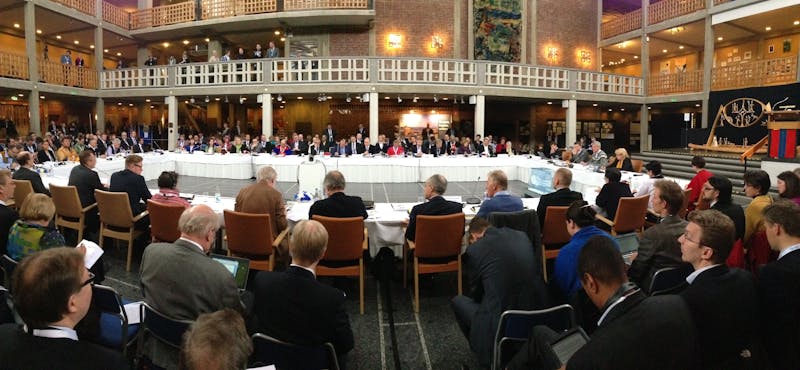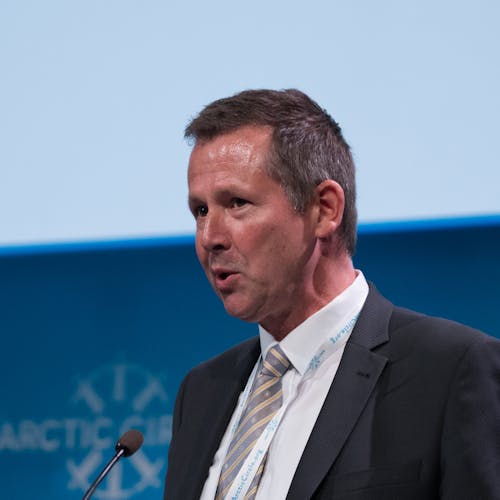The Finnish Initiative/Rovaniemi Process
During the Cold War, the Arctic was the epicenter of nuclear deterrence and the stomping ground of nuclear submarines of the United States and the Soviet Union. Scientific collaboration between western states and the Soviet Union existed, but was limited to bilateral cooperation. The situation changed when Mikhail Gorbachev (at that time General Secretary of the Communist Party of the Soviet Union) introduced the Russian terms “Glasnost” (openness) and “Perestroika” (reconfiguration) and his famous Murmansk speech on 1 October 1987 can be considered a milestone for international cooperation in the Arctic. In his speech [1], Gorbachev made several proposals focusing on the Arctic Region:
- “First of all, I would like to invite the countries of the region to a discussion on the burning security issues…
- Secondly, the Soviet Union proposes consultations between the Warsaw Treaty Organization and the NATO on restricting military activity...
- Thirdly, the Soviet Union attaches much importance to the peaceful cooperation in developing the resources of the North...
- Fourthly, the scientific exploration of the Arctic is of immense importance...
- Fifthly, we attach special importance to the cooperation of the northern countries in environmental protection…
- Sixthly, we could open the Northern Sea Route to foreign ships, with ourselves providing the service of icebreakers...”
The speech triggered a discussion of the Arctic States. It should be noted that initially, only the five Arctic Ocean rim countries (Canada, Denmark, Norway, Soviet Union and USA) were considered “Arctic States”, but later Finland and Sweden and Iceland were added to the list. It was Finland that took the initiative to invite the other Arctic States to discuss Arctic environmental protection. The focus was on transboundary contaminants - climate change had not been identified as an issue in the late 1980s. After a series of preparatory meetings, the main meeting took place in Rovaniemi in June 1991, where the Arctic Environmental Protection Strategy (AEPS)[2] was adopted with the Rovaniemi Declaration, signed by the ministers of the environment. The development of the AEPS is today referred to as the “Finnish Initiative” or “Rovaniemi Process”.[3]
With the Rovaniemi Declaration, four working groups were established, which are still active today within the Arctic Council: Arctic Monitoring and Assessment Programme (AMAP), Protection of the Arctic Marine Environment (PAME), Emergency Prevention, Preparedness and Response (EPPR) and Conservation of Arctic Flora and Fauna (CAFF).
Three organizations, representing the Indigenous Peoples of the Arctic, became Permanent Participants (PP): Inuit Circumpolar Council (ICC), Saami Council and Russian Association of Indigenous Peoples of the North (RAIPON). Germany, Poland, the United Kingdom and the United Nations participated in the meeting as observers. Thus, an early Arctic Council was born and a platform for further cooperation in the Arctic was established.
International Arctic Science Committee (IASC)
The Rovaniemi Process was paralleled by a discussion on international scientific cooperation which was mainly driven by Norway. The idea was to develop an Arctic scientific organization similar to the Scientific Committee on Antarctic Research (SCAR), which dates back to the International Geophysical Year 1957/1958. Following consultations with the Arctic States and a series of pre-meetings, the founding meeting of the International Arctic Science Committee (IASC) took place in Resolute Bay (Canada) in August 1990. The Founding Articles were signed by representatives of the science organizations of the eight Arctic States. Representatives of some non-Arctic States participated as observers but already in January 1991, at the first IASC Council Meeting, the science organizations of the Federal Republic of Germany, France, Japan, the Netherland, Poland and the UK were admitted as full members of IASC. [4] Since then, IASC has evolved into the leading international science organization for the North and its membership today includes science organizations from 24 countries, all of which have the same status. IASC´s mission is to “encourage and facilitate cooperation in all aspects of Arctic research, in all countries engaged in Arctic research and in all areas of the Arctic region” and “overall, IASC promotes and supports leading-edge interdisciplinary research in order to foster a greater scientific understanding of the Arctic region and its role in the Earth system.” [5] Since 2011 IASC has supported five disciplinary Working Groups that lead the development of new initiatives, as well as cross-cutting, interdisciplinary activities.
IASC´s strength is that it brings together the scientific expertise from all of its member countries. In addition, IASC has developed close partnerships with many other Arctic and Polar science organizations. Using this aggregated expertise, IASC has been able to actively shape the Arctic research agenda, in particular though research planning activities, such as the International Conference on Arctic Research Planning (ICARP). [6] The best example is the MOSAiC (Multidisciplinary drifting Observatory for the Study of Arctic Climate) expedition that was initiated and developed under the auspices of IASC. [7] MOSAiC was the largest polar expedition in history, with the German research icebreaker Polarstern drifting one full year through the Arctic Ocean, trapped in the sea-ice. Following in the footsteps of Fridtjof Nansen's Fram expedition in 1893-1896, hundreds of researchers from 20 countries were involved in the MOSAiC expedition.
Arctic Council
Following the establishment of the Arctic Environmental Protection Strategy, the discussions on broadening the forum continued and in particular Canada promoted the idea of a more extensive Arctic Council. Finally, in 1996, the Arctic Council was formally established with the Ottawa Declaration [8], which defines the Council as a high-level intergovernmental forum to “enhance cooperation, coordination and interaction among the Arctic States with the active involvement of Arctic Indigenous Peoples and other Arctic inhabitants on common Arctic issues”. In addition to environmental protection, sustainable development was included in the mandate and in 1998 the Sustainable Development Working Group (SDWG) was created. The sixth Working Group Arctic Contaminants Action Program (ACAP) was established in 2006. Three additional Indigenous People´s organizations – Aleut International Association (AIA), Arctic Athabaskan Council (AAC) and Gwich´in Council International (GCI) – were admitted as Permanent Participants and a growing number of Observer States and Observer Organizations were accredited. IASC was among the first group of observers that were accredited in 1998.
The decisions of the Arctic Council require the approval of all member states and are taken in consultation with the Permanent Participants. This active involvement of and consultation with the Indigenous People´s organizations is a unique feature. Observers are invited to the meetings of the Council and encouraged to make relevant contributions primarily at the level of Working Groups. [9],[10]
During its first 25 years, the Arctic Council has initiated and implemented a multitude of measures to protect the Arctic environment, to counteract contamination, to support the well-being of Arctic inhabitants and to facilitate the sustainable development of the region. In particular the Arctic Council assessments conducted by its Working Groups have become very successful instruments to compile the state of knowledge and to formulate policy recommendations for the member states. The 2005 Arctic Climate Impact Assessment (ACIA), organized and managed as a joint venture of the CAFF and AMAP Working Groups of the Council and IASC, can be considered a milestone regarding the understanding of the impacts of climate change on the Arctic environment and inhabitants. [11]
Even though the guidelines and recommendations of the Arctic Council are not legally binding - their implementation is the responsibility of the member states – the Council has initiated and facilitated three legally-binding agreements among the Arctic States:
- The Agreement on Cooperation on Aeronautical and Maritime Search and Rescue in the Arctic (2011) [12] coordinates international search and rescue (SAR) coverage and response in the Arctic and defines the area of SAR responsibility of each Arctic State.
- The Agreement on Cooperation on Marine Oil Pollution Preparedness and Response in the Arctic (2013) [13] is designed to strengthen cooperation, coordination and mutual assistance among the Arctic States on preparedness and response to oil pollution in the Arctic.
- The Agreement on Enhancing International Arctic Scientific Cooperation (2017) [14] aims at enhancing cooperation in scientific activities in order to increase effectiveness and efficiency in the development of scientific knowledge about the Arctic.
In this context, two other legally-binding agreements that are not associated with the Arctic Council should be mentioned:
- The International Code for Ships Operating in Polar Waters (Polar Code) was developed by the International Maritime Organization (IMO) and entered into force 2017. The Polar Code specifies “design, construction, equipment, operational, training, search and rescue and environmental protection matters relevant to ships operating in the inhospitable waters surrounding the two poles”. [15]
- The Agreement to Prevent Unregulated High Seas Fisheries in the Central Arctic Ocean was signed by the five Arctic Ocean coastal states (Canada, Kingdom of Denmark via Greenland, Norway, Russia and the United States), Iceland, the European Union, Japan, Korea and China in 2018. The Agreement is to “prevent unregulated fishing through the application of precautionary conservation and management measures as part of a long-term strategy to safeguard healthy marine ecosystems and to ensure the conservation and sustainable use of fish stocks.” [16]
The mandate of the Arctic Council is restricted to environmental protection and sustainable development. Other topics are not addressed and in particular military security is explicitly excluded. However, the Council served as a catalyst for the formation of independently operating organizations addressing additional topics. The Arctic Economic Council (AEC) [17], an independent organization that facilitates Arctic business-to-business activities and responsible economic development, started from an initiative of the Arctic Council. Also the Arctic Coast Guard Forum (ACGF) [18], an independent, informal, operationally-driven organization to foster safe, secure, and environmentally responsible maritime activity in the Arctic, is independent of but complimentary to the Arctic Council.
Another important initiative of the Arctic Council is the University of the Arctic (UArctic), “a network of universities, colleges, research institutes, and other organizations concerned with education and research in and about the North”. UArctic was formally launched 2001 in Rovaniemi (Finland) and goes back to a feasibility study on an Arctic university commissioned by the Arctic Council in 1997. UArctic promotes cooperation in education, research and outreach to enhance human capacity in the North and to date has more than 200 member institutions and organizations from the eight Arctic states and beyond. [19]



